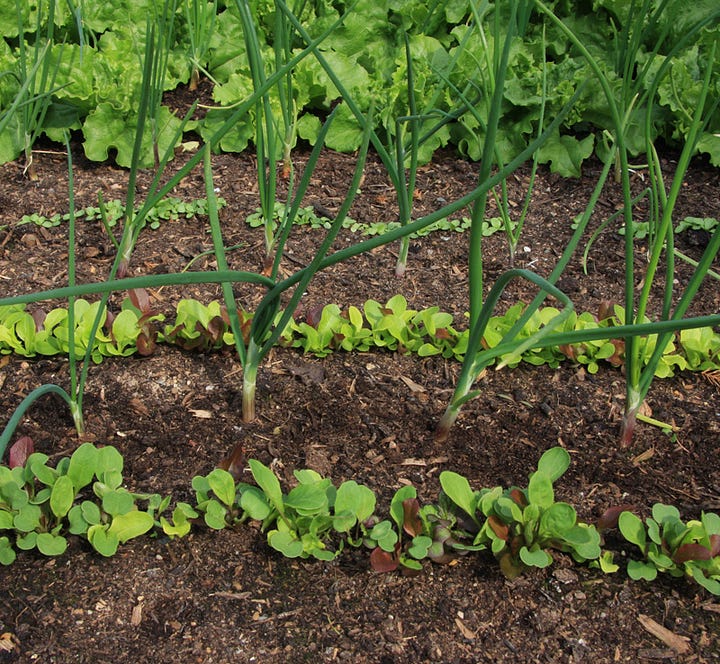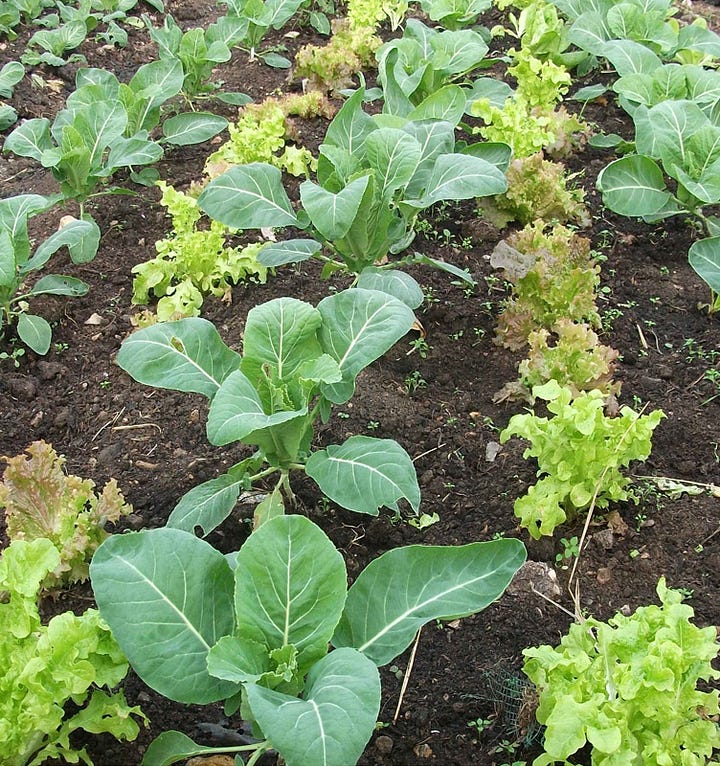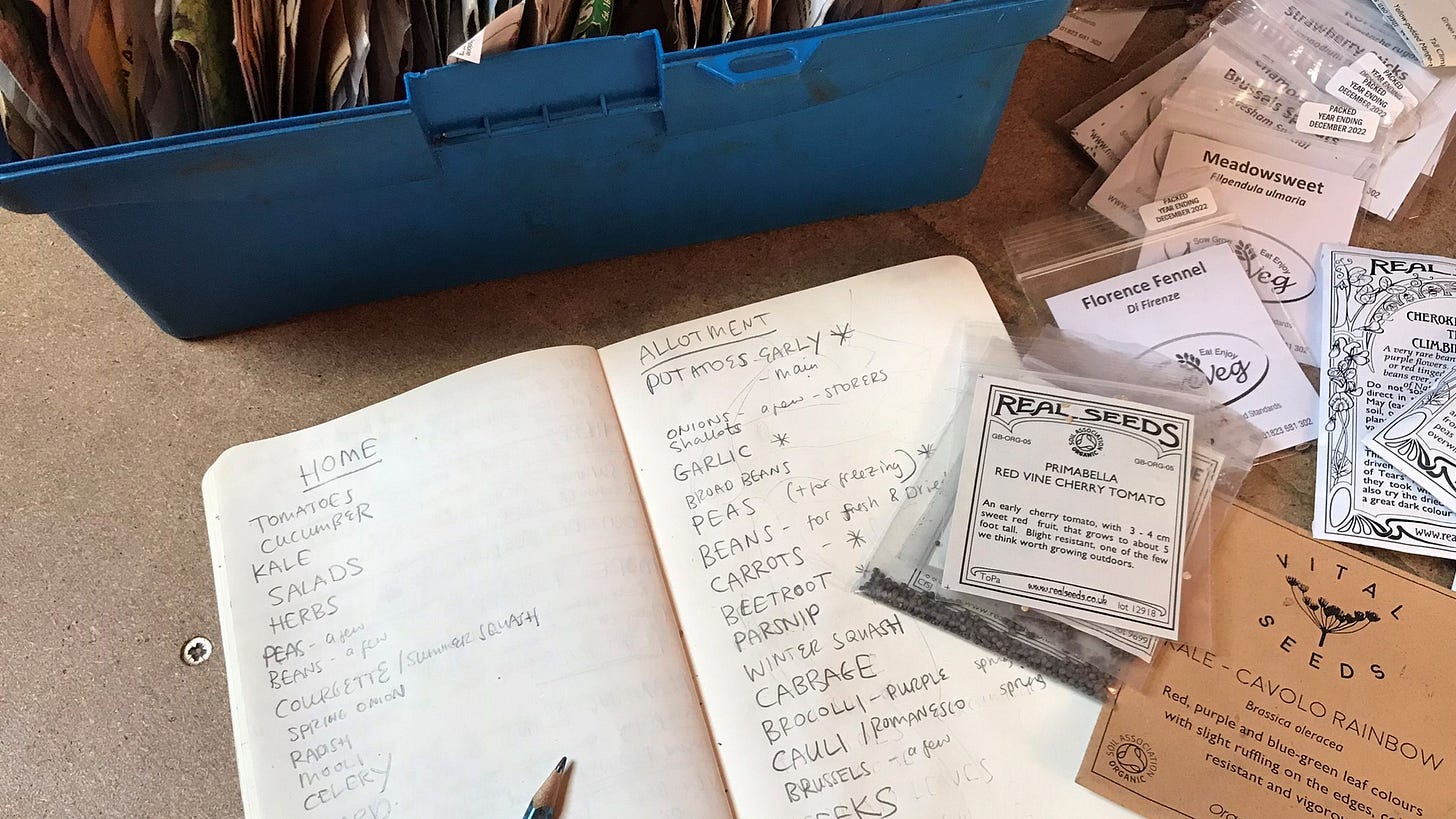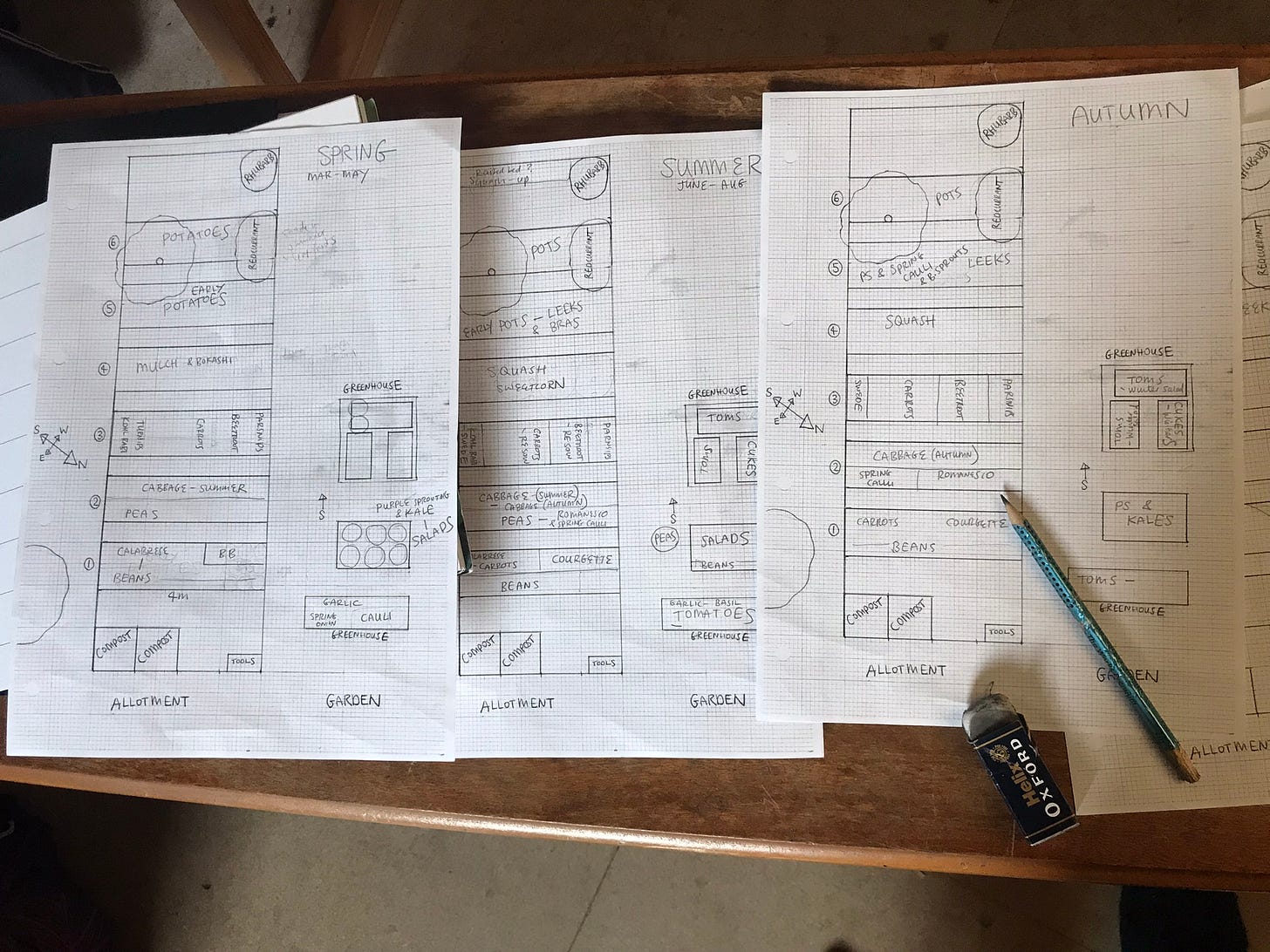Planning out your veggie plot?
If you struggle with timings of sowing veggie seeds, then creating a simple plan will cut out overwhelm and help you grow MORE food with LESS work.
If you’re anything like me, you get really excited looking at seed catalogues, and want to grow ALL of the things! That amazing candy striped beetroot, the cute little cucamelons everyones raving about, hilarious shaped tromborcinos and leaves of all colours and textures. So many packets of potential!
So you order waaay too many seeds, but you haven’t got space for all of them, and when the weather hots up and the enthusiasm of spring starts to wane, you forget to sow half of them and find them still languishing in your overstuffed seed box at the end of the season. Time to make a plan!
Why plan
Creating a plan of your vegetable plot means you can grow MORE food with LESS work by:
Making the most of the space, filling all of the gaps.
Ordering and sowing the right amount of seeds
Making it easy to remember WHAT to sow, and WHEN
Avoiding overwhelm by making decisions at the start of the season
In the midst of the growing season, when you are busy with lots of other jobs, you will be glad to already have your plan in place!
How to plan
There are many different ways to plan out your plot, ranging from the simplest back of an envelope sketch, to accurate scale drawings with complex speadsheets. I have used the whole range, during my years managing various community gardens and my own allotment and home garden, and they all work well in the right situation.
Many years ago, when I first started out on my allotment, I used to simply sketch out the beds, not to scale, and indicate the approximate area for each crop, sometimes using an arrow to indicate what it could be followed by, for example early potatoes - leeks.
This simple method worked ok, as I had a large allotment plot and didn’t need to be that precise, and through many years experience I actually got quite skilled at anticipating gaps and would often know intuitivley how many seeds to sow.
But I noticed that I still very often had empty beds in between crops, or all winter. Although I generally remembered to sow seeds in spring, I quite often forgot to sow some of the plants in summer, such as purple sprouting broccoli or winter salads, that would make my plot more productive over the autumn, winter and early spring.
Successful plot plans travel through SPACE, CROPS and TIME
(to explore the final frontier of vegetable growing!)
In a nutshell, you draw out your vegetable beds, to scale or not, to show the SPACE you have available. You decide what CROPS to plant, noting how much SPACE they take up, and indicate the TIMINGS to show how long they will be in the ground.
It was actually through running a large public edible garden (Sustainable Garden) that I developed my veggie plot planning skills. We had two staff members and lots of volunteers, and so my imprecise, intuitive method was difficult to translate for others, with varying experience, to follow. And our garden was in the centre of a busy university campus, with LOTS of people picking food, so we had to grow as much as we possiby could!
We had a massive spreadsheet which told us precisely what to plant, how many seeds, where and when, but nowadays I don’t need that level of precision.
I’m going to go through the method I use for my small home garden and allotment, but this is by no means the only way! As with all growing, experiment to discover what works for you.
1) Check seeds.
I start by getting out all of my seed packets to see what I have already, and check dates. Some seeds last longer than others, and if you’re not sure if they are still viable you can do a quick germination test on some wet kitchen towel.
2) Write your wish list
Using my seeds as a starting point, I write out a list of ALL of the veggies that I want to grow this season. Then I circle or star the absolute must haves, so I know what to prioritise.
3) Sketch out beds
You can do this to scale or not, depending on how precise you want to be, and how much time you have. (any sketch is better then none!) Squared or graph paper is REALLY useful at this point, but not essential. I use paper and pencil, but if you prefer computers you can draw beds out in excel or another program.
It can also be useful to add the direction of the sun to your sketch, but the beds don’t have to be arranged as they are in the garden, as often it’s easier to see them all on one page. (For example I sketch my allotment and garden beds on the same page.) Once you have a blank sketch, make a copy before drawing on it, as you can use this again next year.
4) Make a copy for each season (optional)
For the most basic, starter plan, it’s possible to indicate the time on one sketch, using arrows and writing on approx times. If you feel overwhelmed by the following points, then start with this.
Some growers will precisely map out beds for every month, and that is certainly a good way of being super productive, but not necessary for most home growers.
I find it sufficient to make three copies of my blank plan- SPRING, SUMMER andAUTUMN/WINTER.
5) Add the plants
This is the exciting part! Go back to your wish list, and start deciding which plants are going in each bed, for each season- Spring (March-May), Summer (June-Aug), Autumn/winter (Sep-Feb).
Use a pencil as you will probably move things around a bit!
I add bigger and longer growing crops first, such as potatoes, tomatoes, winter squash, courgettes, beans, onions and brassicas (broccoli, cabbage, brussel spouts, kale), as well as my absolute must-haves.
Then I find space for smaller, quicker growing crops such as lettuce, carrots, kale, radish, beetroot and fennel. I see if they can fit in and around the larger crops, for example you may be able to fit a row of beetroot in front of your beans, or some lettuce underneath them, or sometimes put them in a section at the end of a bed.
Thinlk about the height of tall growing plants, and place them to the north of your plot, so they don’t shade out other plants. And try to place sun-loving plants where they will get the most sun.
Some plants such as main crop potatoes will be on your spring and summer plans, whereas early potatoes can be harvested in mid-summer. In this case I draw an arrow to indicate that they can be followed by a summer crop.
For a more detailed plan you need to know:
When to plant: If you are in the UK or similar climate, check out my free veggie sowing calendar to see what you can sow when, for the best results. Seeds sown in modules can be planted approx four weeks after sowing. (tomatoes, chillis and aubvergines are an exception to this)
Approx time to harvest. Real seeds have this information next to all of their seeds (and a great place to buy seeds from as well!). Over the years you will get more precise timings, based on your unique climate
Approx size of plants, or distance between rows for smaller plants. This varies slighty depending on variety. (square paper is super useful for showing the size)
If you are a complete beginner I would keep it simple by starting with a few types of plants!


6) Getting more from your space
You can fill any gaps in time with intercropping and catch crops such as quick-growing salad leaves to use the space around slow growing brassicas, or rows of quick-growing radish in betwen rows of slow-growing parsnips.
In some cases you can overlap the timings of crops to make more of the space. This is when you plant in seedlings for the next crop before the first one is finished. For example I plant my winter salads around my tomatoes in early autumn, removing the lower leaves of the tomatoes to increase light, and small brassica seedlings can often be fitted in gaps of recently harvested carrots or beetroot, that will be fully harvested by the time they have grown big.
7) Order seeds
With your plan and the seeds you already have in hand, browse online seed suppliers or your local garden centre to buy more seeds if you need to. Having a plan usually means I don’t just buy everything, but even so I still normally end up with too many!
8) Add sowing dates to your calendar
Whether its a wall calendar or your online calendar, adding in the sowing dates of your most important seeds is the final, but not to be overlooked step. Don’t waste all of your planning time by missing out this step! One option could be to print out the veggie sowing calendar (link below) and circle the veggies you want to sow..
Need some more help?
If you are in the UK or similar climate, check out my free veggie sowing calendar to see what you can sow when, for the best results.
And if you want some personal feedback, come along to my Plan your Plot Workshop and create a plan together with me. Its only £44 and could help you grow much more food with less work!
Have you planned out what you are sowing this year yet? How do you plan out your plot?










